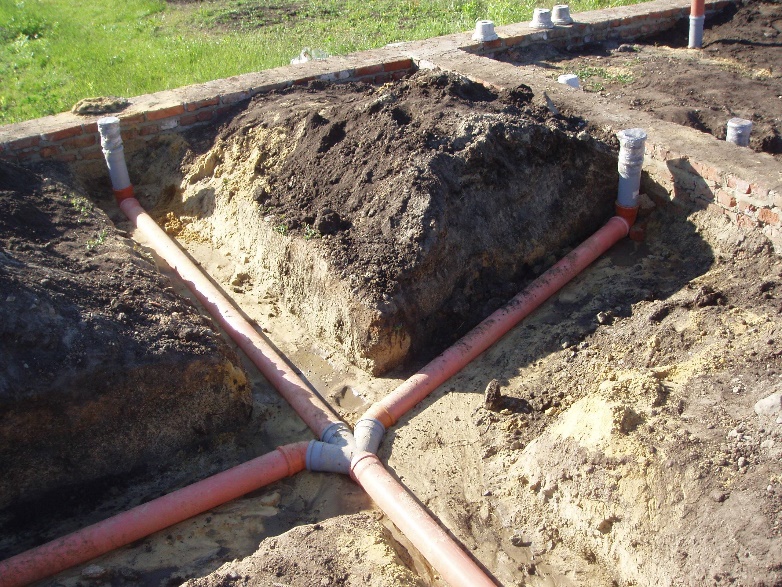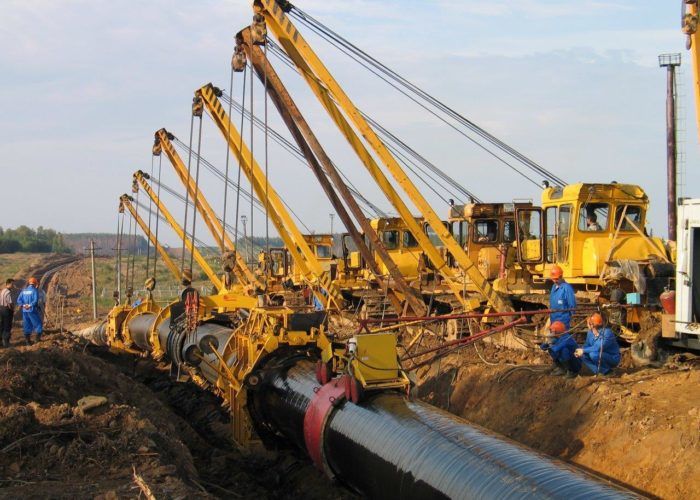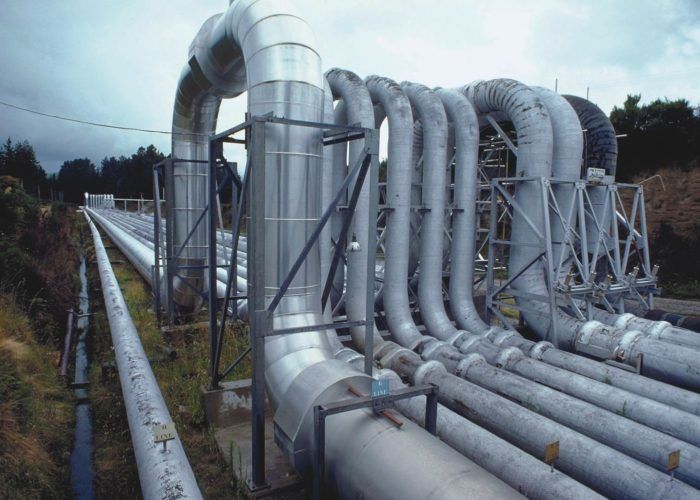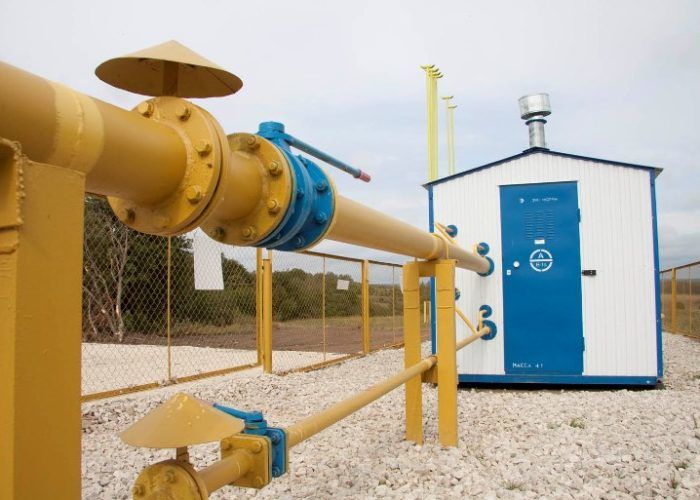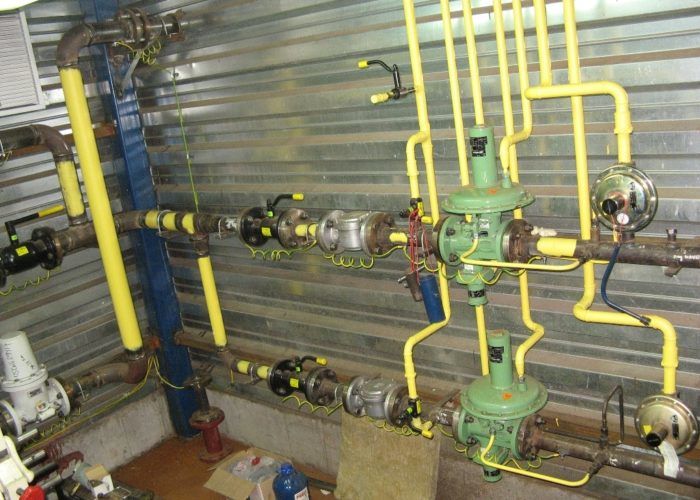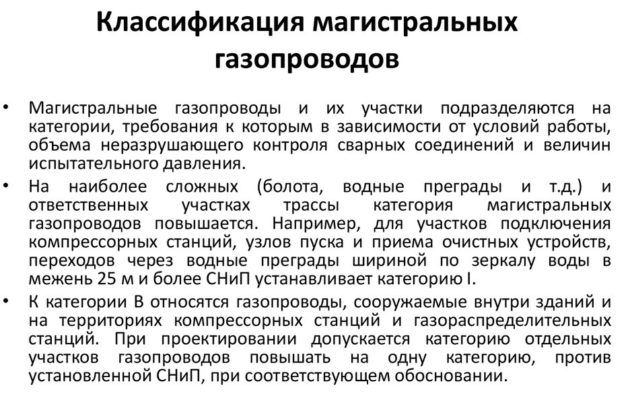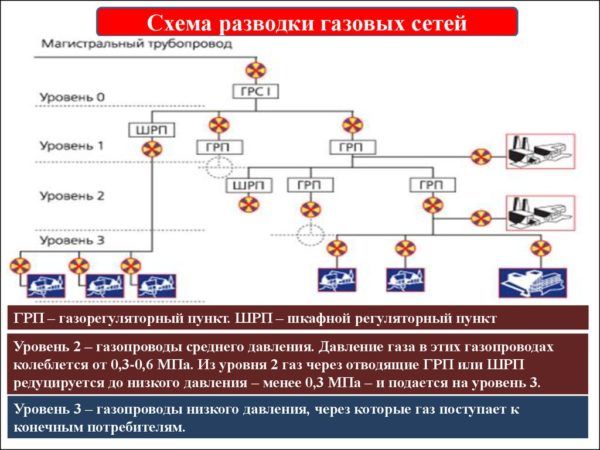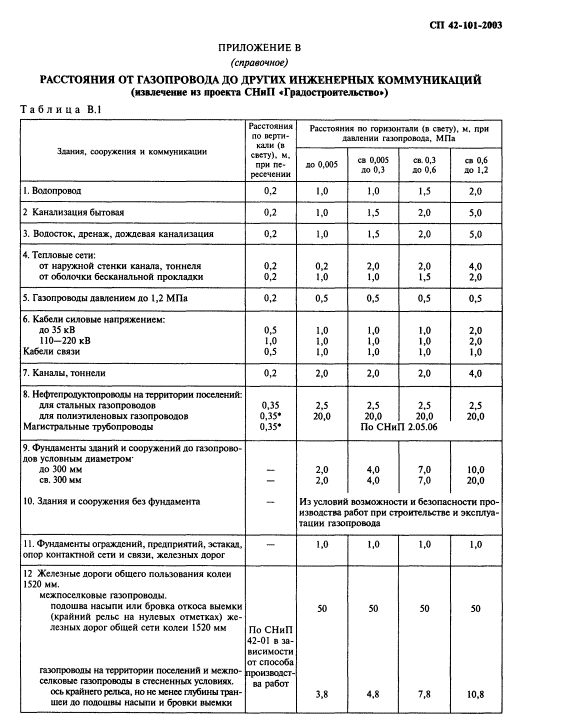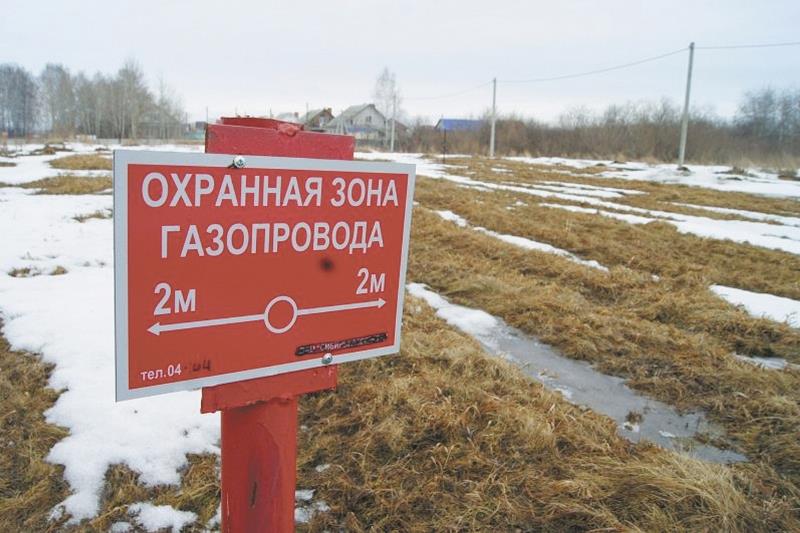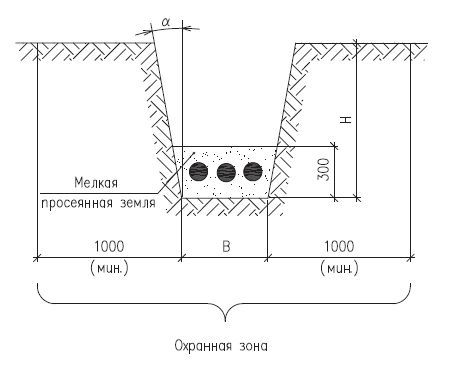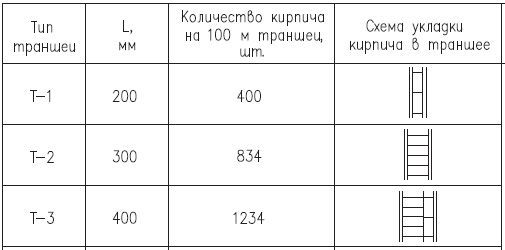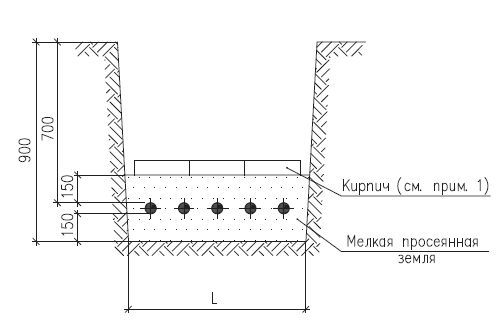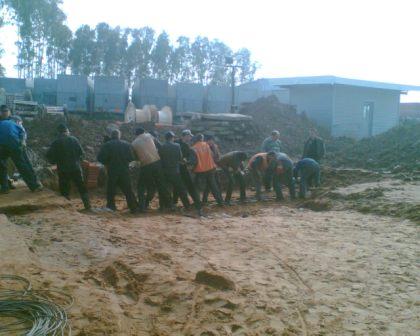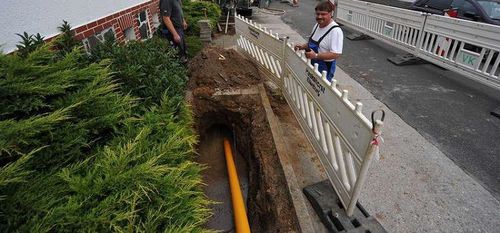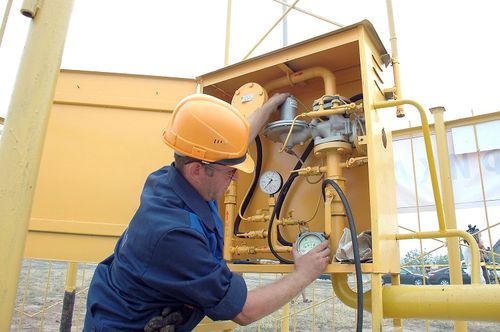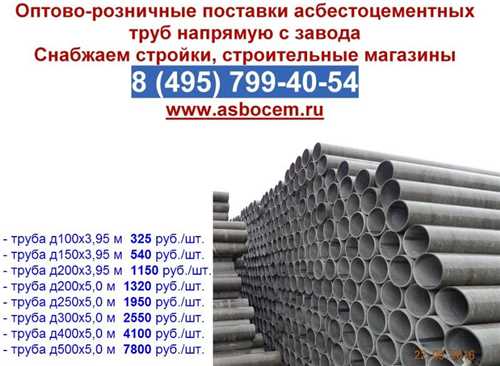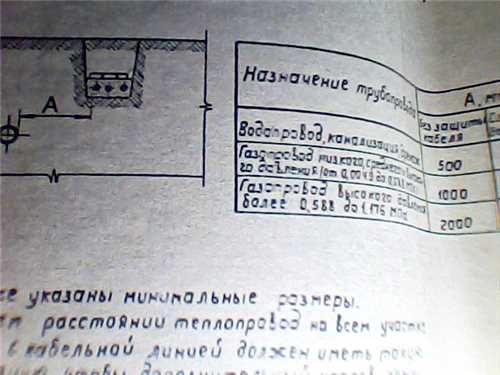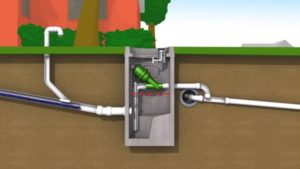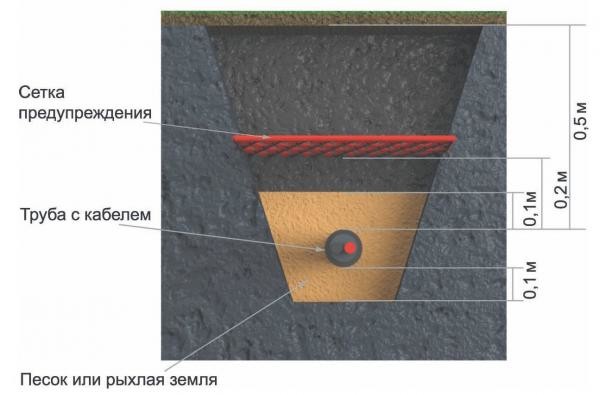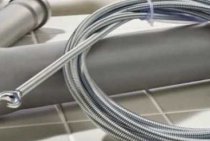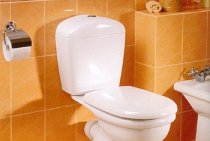Depth of pipe laying near the house
When installing a sewer system, you should be aware that the depth of laying the pipeline can vary in different places
It is important that it is not less than the depth of soil freezing.
An exception can be made in the place where the sewer pipe leaves the house. According to generally accepted technological standards, the pipe near the house should be buried 30 cm above the freezing depth of the soil in the region in which construction is underway. But at the same time, the laying depth should not be less than 70 cm. Many builders look at general standards and lay the pipeline 50 cm deep, which does not lead to irreparable consequences. Such a violation can be made if a road or sidewalk is not laid over the pipe.
Varieties of gas pipelines
Gas pipeline communications are classified depending on pressure and location.
According to the level of pressure can be:

- low pressure (up to 5 kPa);
- medium pressure (up to 0.3 MPa);
- high pressure (up to 1.2 MPa).
Gas pipelines with medium and high pressure are designed to supply gas to industrial production enterprises and gas distribution stations, so it is advisable to build them as a resource for large-scale production.
The low pressure gas pipeline is used to supply gas directly to dwellings, so it is necessary to build it for settlements, residential and public facilities.
By location, they can be of the following type:
- underground;
- ground;
- outdoor;
- internal.
Installation of each type has its own characteristics and nuances. The choice of a method for laying a gas pipeline depends on many indicators, for example, the characteristic properties of the soil, climatic conditions.
Gas pipeline communications are divided into:
- main gas pipelines;
- gas pipelines of distribution networks.
Main gas pipelines. Designed to deliver gas over long distances. At certain distances, gas compressor stations should be installed, which are designed to maintain pressure.
Gas pipelines of distribution networks are designed to supply gas from gas distribution stations to consumers.
Laying of external and internal gas pipelines
Internal gas pipeline - a system of pipes and communications located inside buildings. The piping in this case should not be covered with any additional overlays or hidden in the wall, there should be free access for regular preventive examination and repair work.
When gas communication is located by the external method, the access of strangers to it should be as limited as possible. For this, structural elements are mounted at a sufficiently high height. The fixing of pipes to the walls of the facade must be reliable in order to prevent the fall of the gas pipe.
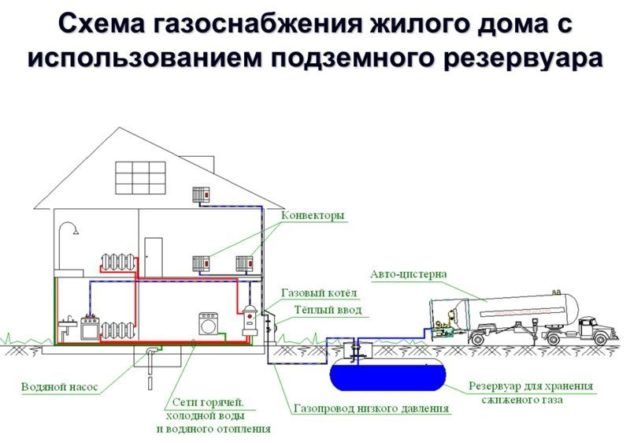
Rules for the location of pipes on the site
The laying of gas systems on the land plot can be carried out:
- in the ground. The internal gas pipeline allows you to save the usable space of the site and "hide" the main communications;
- along the surface. Outdoor piping will cost less, but pipes running through the site limit space.
During the construction of any type of pipeline, it is required to follow the rules for laying pipes, which are established by SNIP 42-01-2002.
Pipe Laying Restrictions
At what distance from the gas pipe should the foundation of the house be located? The distance from the house to the pipeline depends on the parameters of the communication system, in particular pressure:
- a line with low pressure (not more than 0.05 kgf / cm²), which is typical for pipelines supplying fuel to private consumers, should be located at least 2 m;
- a pipeline with average pressure indicators (from 0.05 kgf / cm² to 3.0 kgf / cm²) used for laying central systems can be located at a distance of 4 m;
- a high-pressure pipeline system (up to 6.0 kgf/cm²), which provides gas to enterprises and economic complexes, can only pass at a distance of 7 m or more.
Varieties of gas pipelines by pressure
The outdoor piping must not pass:
- at a distance of less than 50 cm from window and door openings;
- at a distance of less than 20 cm to the roof of the room;
Distances to other communications (water supply, sewerage, and so on) are presented in the following table.
The location of single pipes relative to other communications
Gas pipeline security zone
In addition to the rules for the location of pipes, when laying a gas pipeline, the presence of a security zone should also be taken into account.
Under the security zone of the gas pipeline system is meant the distance between the communication pipe and two conditional lines running parallel on one side and the other.
Depending on the pressure in the gas supply line, the size of the security zone is:
- for low pressure pipelines - 2 m;
- for lines with an average pressure value - 4 m;
- for pipes with high pressure - 7 m.
The special zone of the gas supply system can be increased:
- for pipelines made of polyethylene pipes (up to 3 m);
- for highways laid in permafrost conditions (up to 10 m);
- for systems laid under water (up to 100 m);
- for routes laid in the forest belt (up to 3 m).
The size of the buffer zone is indicated on the information plate installed on the pipeline.
Presence and size of the buffer zone
Within the security zone it is prohibited:
- construction of any structures;
- arrangement of cesspools;
- arrangement of places for storage of toxic and chemically active compounds;
- installation of fences and other barriers. The minimum distance from the fence is determined by the size of the protected area;
- kindle a fire;
- cultivate the soil to a depth of more than 30 cm (for underground utilities).
Trench for laying the power cable at home - trench device
Important! The trench should have a slope towards the support of 5 degrees so that water does not accumulate at the foundation of the house. (SNiP 3.05.06-85)
The trench for laying the power cable to the house should have the shape of an inverted trapezoid in section. The depth of the trench should be 90 cm. The width of the trench at the bottom should be at least 20 cm. It is difficult to drip manually into such a trench, so it is more reasonable to make the trench width 40 cm.
At the bottom of the trench, you need to lay a bed of sand or sifted earth. The thickness of the bedding is 10 cm.
- An electrical cable is laid on the bedding. The cable is covered with sand. The initial backfill thickness should also be 15 cm.
- The backfill over the cable must be tamped. To do this, the sand must be wetted and compacted to a thickness of 10 cm.
- Sand filling has two purposes. It protects the cable and is a kind of signaling device. During earthworks near the trench, sand that has appeared will indicate the proximity of an electric cable.
- For better signaling of approaching an electrical cable, a special signal tape is used. The signal tape is laid at a distance of 25 cm from the cable cover. That is, after 10 cm of sand filling and 15 cm of neutral soil.
- It is forbidden to use a signal tape at the intersection of the route of other utilities. The tape should not be 2 meters on each side of the intersection. (PUE 2.3.83)
- A more reliable protection of the electrical cable in the trench will be the laying of red brick in one layer on top of the sand backfill. See the brick laying scheme, but the figure below. In the figure, L is the width of the trench.
Note1: It is not necessary to protect the electrical cable in the trench with a layer of bricks, since the 220/380 volt supply voltage does not apply to high voltage. But if it is possible to protect your power cable with a layer of brick, it is better to protect it.Not prevent.
Note 2: After laying the cable, backfilling with sand and laying signal tape or bricks, you need to draw up an act of performing hidden work. After signing the act, you can fill the trench completely.
- When finally falling asleep, make sure that there is no construction debris, gypsum, lime, slag in the soil. It is desirable that the soil for backfilling be neutral.
- Before starting work, the trench must also be checked for the absence of water, debris and foreign loose mixtures.
Choosing a cable for laying power at home in a trench
When using armored cable VBbShv for power supply of a private house, as well as its analogues or modifications in neutral ground, it is not required to protect the cable with pipes.
When using non-armored cables in plastic and rubber insulation, such as VVGng, the cable must be laid in pipes. Pipes must be special, made of plastic. The cable is tightened into the pipes after the pipes are laid in the trench. The work is "still the same".
That's all! Treat electricians with respect!
Normative references:
- PUE, ed.7, chapter 2.3 (Cable lines up to 220 V)
- SNiP 3.04.03-85 "Protection of building structures and facilities against corrosion"
- SNiP 3.05.06-85 "Electrical devices"
- INSTRUCTIONS FOR INSTALLATION OF ELECTRICAL WIRINGS IN PIPES, Concern: "Electromontazh".
Other articles in the section: Wiring at home
-
26 Rules for power supply and wiring of a wooden house. part 1, rules 1-7
-
26 Rules for power supply and wiring of a wooden house. part 2, rules 8-13
-
26 Rules for power supply and wiring of a wooden house. part 3, rules 14-26
-
Anchor clamps and brackets
-
Fittings for SIP 2
-
Entering the cable from the trench into the house
-
input device. VU in a private house
-
ASU. Introductory switchgear at home
-
GZSH. Main Ground Bar
-
Deep grounding
Section: Home connection
-
input device. VU in a private house
-
ASU. Introductory switchgear at home
-
GZSH. Main Ground Bar
-
Branch piercing clamp
-
Connecting a branch power supply of a private house to an overhead line
-
Connecting SIP from the highway to the house
Underground laying rules
To find out where the gas pipe is laid in the ground, in order to connect to the main, you need to contact the appropriate service of the summer cottage or settlement. There you can also find out the recommended installation method and involve a team. Independent installation of the gas pipeline is strictly prohibited.
To lay the gas pipe correctly, consider the following safety rules:
- at the entrance to the building, the depth can be reduced to 0.8–1.2 m;
- the medium pressure gas pipeline is mounted with a slope of 1.5 mm per linear meter: this prevents the appearance of water plugs and the accumulation of condensate;
- if wet gas is transported, then the gas pipeline is located below the level of freezing of the earth, and the entrance to the building or bath is carried out through the foundation. If the gas is dry, then a smaller depth is allowed, and the inlet can be placed in the wall;
- areas where detachable connections are used are located in manholes.
The device of the gas pipeline in a private house
Installation of the system is carried out only by gas services. But, of course, anyone can learn how to lay a gas pipe around the house. Here, too, it is necessary to adhere to a number of rules that exclude certain types of installation.
The fact is that the gas supply pipe should be periodically inspected. Therefore, hidden mounting methods are excluded.
- The gas pipeline enters the building or bathhouse through the foundation or wall, always in non-residential premises. Here you need to organize the wiring around the building.
- It is allowed to transit the gas pipeline through the dwelling, but in this case the gas pipe does not contain any fittings or threaded connections.
- The medium pressure gas pipeline is mounted in an open form at a distance from the floor, which is the same as the installed gas appliances. The distance from the floor in other areas is 2.10 m.
- It is not allowed to pass the pipe through window or door openings, ventilation shafts.
- Is it possible to lay a gas pipe in the floor? No. The system must be easily accessible at all times.Even the location above the plinth and on the floor is not allowed.
- It is possible to install the pipeline in strobes on the wall, provided that they are covered with a removable finish, which can be removed at any time. However, in this case, it is necessary to observe the recommended distance from the floor. In the photo - strobes for laying.
All work with the gas pipeline is associated with a certain risk. Therefore, at the time of installation and connection, people should be removed from the private house.
Installation of a gas pipe on the site
Two types of gas pipeline laying are allowed: underground and ground.
Ground - the pipeline is laid on supports. The main advantage of the method is a much lower installation cost, saving up to 60%. However, the onshore gas pipeline must be adequately protected against corrosion and thermally insulated. In addition, such an object needs to be constantly checked for mechanical deformations. In general, the design is considered less reliable than underground.
Underground - the pipe is laid in a specially dug trench. Thermal insulation is also necessary here, but this method protects the gas pipeline from any mechanical damage.
Laying technology and assembly rules
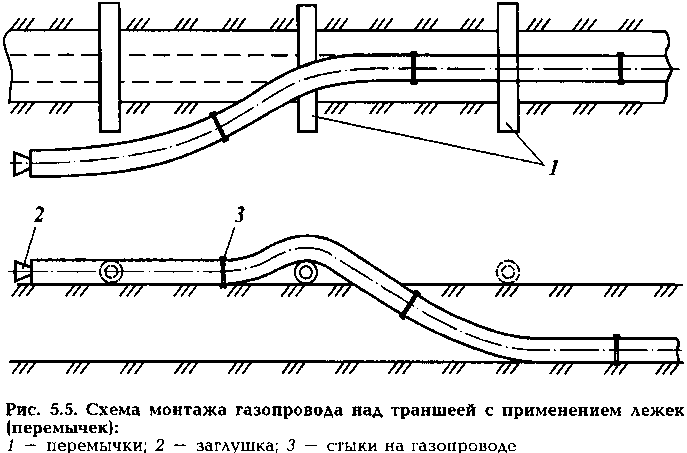
The laying of gas pipeline communications is a difficult and time-consuming process, which is carried out in stages and includes several stages. A preparatory stage is required, including the development of a gas pipeline project.
The project should be developed only by qualified specialists; on its basis, installation will be carried out in the future. The project must necessarily take into account the features of the landscape and soil of the site where the installation work will be carried out, as well as the climatic conditions of the area.
The second stage includes the direct work on the installation of gas pipelines. Next, start-up work is carried out.
The final stage is the control of the installed gas pipeline. It is necessary to test it for strength and perform a sealing check of all structural elements. All hydraulic checks can only be carried out after all accessories have been installed.
The gas pipeline is an explosive structure, therefore no construction can be carried out in the immediate vicinity. For this, special columns are used that mark the security zone. The size of the buffer zone depends on the type of gas pipeline. Appropriate warning signs are installed where required.
Main conclusions:
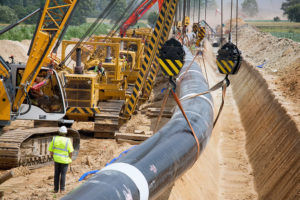
The gas pipeline is a structure that creates a danger.
Installation requires strict adherence to safety regulations, the violation of which can lead to dangerous consequences.
Prepare the necessary technical documentation for the permit and installation of gas equipment.
Only specially trained people should carry out the design and installation process.
It is important to comply with all requirements for materials and components of the gas pipeline.
Expert answers
Sullen:
The water pipe should lie below the freezing depth of the soil, on average, at a depth of 2 meters, the sewer pipe should be slightly higher. . In general, you need to look at SNiPs and follow them! Not there you ask! Find a building forum where there are knowledgeable people! I personally don’t see a particular problem, otherwise they write like that, as if you were not laying pipes, but pouring everything into one well! Do not listen to anyone until they give reasons motivated by something! Fi, I don't like it so much - not an argument! P.S. Here's the info I found... With a parallel arrangement of pipes, the distance between the water supply and sewerage should be more than forty centimeters. It is strictly forbidden to lay sewer networks in the sanitary zone of the water supply. In the event that the intersection of networks is necessary, the pipes should be placed at right angles to each other, crossing at an acute angle is not allowed. As a rule, they try to place water pipes above sewer pipes. At the intersection of networks, the vertical distance should be at least 40 cm. When using polymer pipes for water supply networks, steel casings are put on them at the intersections. The length of the casing depends on the type of soil. In clay soils, this length is five meters on each side of the intersection. In well filtering soils (sand) - ten meters. In difficult cases, when it is required to place the sewer pipe above the water pipe, the steel casing is put on the pipeline through which the drains move. In this case, the distance from the water supply to the sewer should be the same as described above. If repairs are required at the intersection of the sewerage and water pipes, then digging a trench with an excavator is allowed to a depth per meter not reaching the depth of the pipe. Further digging must be carried out manually, without the use of crowbars and other percussion instruments. The distance between the input of water pipes and sewerage into the house must be at least one and a half meters. " A source.
Pistachio:
No way.. phew.. Break the pipes away. IMHO
HUMAN:
and why two pipes ... you can start up both water and sewage one at a time ...
Alexei:
it is possible if the water supply is made of HDPE without couplings, the previously existing norms were written for cast iron - without pressure.
PND only fall asleep with seeded sand, then pierce it with stones, it is weak
Andrey Volkov:
It’s possible - you just need a shelf under the sewer pipes from the end of the trench wall (dig a step in the ground under the required slope separately. Otherwise, when the soil shrinks, anything can happen. It’s just that you threw everything in and buried it. dig in from the side
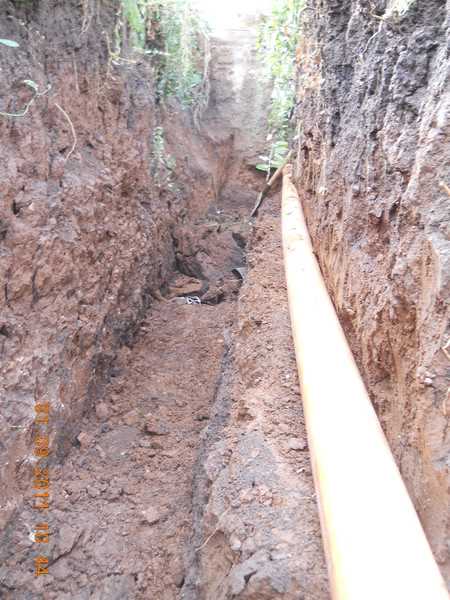 |
Water pipes need black polyethylene with a blue stripe
Vladimir Belyaev:
That's how my pipes are laid. Plastic: 110mm sewerage, 25mm plumbing.
iRoman:
2. The distance from the domestic sewer to the drinking water supply should be taken, m: to the water supply from reinforced concrete and asbestos-cement pipes - 5; to the water supply from cast-iron pipes with a diameter of up to 200 mm - 1.5, with a diameter of more than 200 mm - 3; to the water supply from plastic pipes - 1.5.
.yourdom /snip/20701-89/index-4
light corner...
there should be 2 meters between the pipes ... And the depth of occurrence is different ...))))))))
Merlin Yarmak:
You can, they do it almost all the time.
Mikhail Savchenko:
Easy! lay down in one trench, less hemorrhoids!
Uncle from the Future...
Rules as mentioned above. But modern materials suggest the possibility of one trench. Only if it's all for individual use. Be sure to insulate and be sure to be in a box so that there is no direct ground pressure. Well, in fact - below the freezing depth. If it is higher, then throw the heating tire onto the pipe.
Maria:
According to sanitary standards - it is impossible.
Anatoly:
And it is better to connect them there and complete order.
Farit Gafuanov:
nothing bad can
Andrey Nikitin:
Best Answers
gray-haired:
not worth it .. read about stray currents.
Serge Clueless:
No, this is prohibited by the PUE, PTE and PTB.
Diesel Uralof:
no need
*** ***:
it’s better to do this: connect the phase to the gas pipeline (isolating it from the main with an insulator) and as a zero - the water supply system does not need any cables AT ALL
vadim dvoeglazou:
Lodge, he is armored
KERK:
Use additional protection for the cable (pipe) and RCD. And do not forget to draw a laying plan with references ..
Nikolay Ivanov:
If the parallel run is small. I don't see any obstacles. Lay in the 63rd pipe (HDPE) and ground the ends of the armor. Good luck.
Andrey Gurich:
you can not do it this way. What if you have to dig up the plumbing?
Minion Boundless:
you can lay it! just a bunch of problems?
VHS:
dig the trench wider, the cable into the pipe and maintain a minimum horizontal distance of 0.25 m for cramped conditions
Vladimir:
in theory, it’s impossible. But in our time and with modern materials, you can. Tighten the cable into a HDPE polyethylene pipe and do not forget to mark the joint gasket on the plan. Lay the tape over the cable before digging the trench. dig, below the cable!”
Valery:
It is impossible in one trench, since the permissible level of laying is different!
Introduction
Hello Dear readers of the site Elesant.ru. Today I want to talk about the power supply to a private house from an overhead line in a trench. Or rather, about all stages of work on the preparation of the trench.
Connecting power to a private house in a trench is not cheap, but the most reliable way to ensure a stable power supply to your home. The cable laid in the trench is completely protected from weather anomalies and accidental mechanical damage. When laying an electrical cable in a trench, there is no restriction on the distance of the house from the overhead distribution line. But the supply of power to the house in a trench underground, like all electrical work, requires compliance with certain rules and regulations. Let's try to figure them out.
Vacuum sewerage of a country house
Vacuum sewerage of a country house
As a rule, when building a house in the shade, literally and figuratively, there remains such a “prose of life” as sewer and water systems, the technical solution of which is a big question for an ordinary homeowner.
Meanwhile, water supply and, accordingly, sewerage are the most important communications in the house, which determine the comfort of suburban living.
In addition, the device of the sewer system is regulated by various laws and regulations.
The future owner of a country house, as a rule, chooses tiles and furniture for the bathroom, the design of sanitary ware and the necessary functional fullness of sanitary equipment.
The designer and the contractor can advise and recommend something, but the decisive vote remains with the customer. However, the ability to navigate the modern variety of plumbing brands (from soap dish and faucet to steam bath) is not all.
Knowledge of sewer network operation methods is required.
The dependence of the depth of the sewerage on the diameter of the pipe

Compliance with the above parameters is not enough for laying a high-quality sewer system. A serious factor is the technical characteristics of the pipes themselves.
First you need to choose the material from which the pipeline is made. Metal and ceramics have long faded into the background and now it is best to purchase pipes made of plastic. Plastic is very resistant to various weather conditions, has a long service life, it is easy to transport and carry.
The next parameter is the diameter of the pipe, on which the depth of laying the sewer system also depends. The larger the diameter of the pipe, the shorter the distance it can be buried in the ground. For example: with an inner pipe diameter of 50 cm and a soil freezing depth of 150 cm, it must be dropped into the ground by 1 m. The formula by which the laying depth is calculated is quite simple: subtract the inner diameter of the pipeline from the freezing depth. This calculation formula is suitable for any private houses.
After calculating the dimensions of the sewer pipes, you can begin to prepare the trench. It is allowed to make the most narrow trenches, but it is strictly forbidden to dig them to a shallower depth.
Standards for cable routes
Let's start with the fact that in order to install the cable in the ground, it is necessary to dig a trench under it. If according to the project it has a small length, then these works are carried out manually.The terrain is also taken into account. In some conditions, shovels are simply indispensable. Basically, digging trenches is carried out with special equipment. The laying itself is necessarily carried out by adding sand, and from above the cable is covered with clean soil without pebbles, debris and slag. The main requirement at this stage is to reduce the risks of mechanical damage to a minimum.
Attention! If a trench is dug for one cable or for several with a width of not more than 250 mm, it is necessary to close it after laying it:
- or burnt brick across the trench;
- or reinforced concrete slabs with a thickness of at least 50 mm;
- or special protective and signal boards made of plastic.
In the process of digging trenches along the entire site, a special signal tape must be installed. It shows the boundaries of the area where work is carried out using special equipment.
This is especially important if the cable is laid near motorways.
Finally
Gas consumption in the modern world is growing. This is due to the relatively low cost, rather high speed of transportation, and a high degree of environmental friendliness of products. Gas is a popular type of fuel, which leads to the expansion of the scope of gas pipeline construction.
It should be borne in mind that gas as a combustible substance poses a certain danger. Therefore, the installation of the gas pipeline must be carried out in accordance with the rules and safety instructions. Strict adherence to installation rules will prevent gas leakage and the possibility of an explosion.
Related video: Installation of a gas pipeline on the facade
A selection of questions
- Mikhail, Lipetsk — What discs for metal cutting should be used?
- Ivan, Moscow — What is the GOST of metal-rolled sheet steel?
- Maksim, Tver — What are the best racks for storing rolled metal products?
- Vladimir, Novosibirsk — What does ultrasonic processing of metals mean without the use of abrasive substances?
- Valery, Moscow — How to forge a knife from a bearing with your own hands?
- Stanislav, Voronezh — What equipment is used for the production of galvanized steel air ducts?
